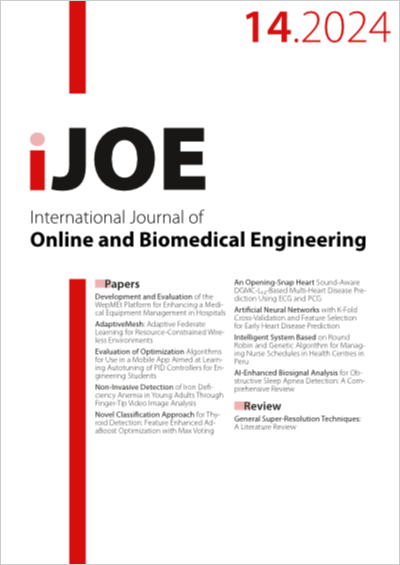An Opening-Snap Heart Sound-Aware DGMC-L1,2-Based Multi-Heart Disease Prediction Using ECG and PCG
DOI:
https://doi.org/10.3991/ijoe.v20i14.51371Keywords:
Multi-Heart Disease Classification, Electrocardiogram, Phonocardiogram, Opening Snap, L1,2-norm regularization based Deep Generalized Extreme Value Mish Convolutional Neural Network, Fuzzy Exponential-Decay-Riseton Inference System, Dendrogram and Osborn Wave.Abstract
Recently, multi-heart disease diagnosis has become a popular research domain. Yet the traditional systems were ineffective due to the limited signal-processing approaches. Therefore, a deep generalized extreme value mish convolutional neural network with L1,2 regularization (DGMC-L1,2)-based multi-heart disease classification is implemented in this paper using electrocardiogram (ECG) and phonocardiogram (PCG). Primarily, the ECG and PCG are gathered and then preprocessed. After preprocessing, the peak waves are identified using the discrete cross-wavelet transform (DCWT). In the same way, the Osborn wave (OW) and opening snap (OS) are predicted from the ECG and PCG, respectively, using fuzzy exponential-decay-riseton inference system (FEDRIS), followed by wave interval segmentation. Furthermore, the dendrogram with a scatter plot is generated, and then the features are extracted. In addition, the peak localized ECG and PCG are fused together. Subsequently, the subsequent derivatives are estimated, and then a bivariate correlation matrix is created. Then, the feature extraction is done, followed by dimensionality reduction. Here, the dimensionalities of the features are reduced using log-linear scaling2—Principal Component Analysis (LS2-PCA) and then fed into the proposed DGMC-L1,2, which effectively predicts multi-heart diseases. Thus, the experimental results proved that the proposed work had high supremacy with an accuracy of 98.99%.
Downloads
Published
How to Cite
Issue
Section
License
Copyright (c) 2024 Dakshayani Himabindu Damineni, Srilakshmi ch, Sravanthi Jakkula, Siva lakshmi B, Satish Kumar M , Prasanthi Yavanamandha

This work is licensed under a Creative Commons Attribution 4.0 International License.



